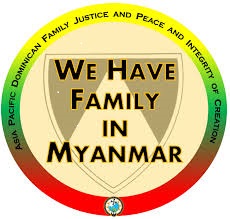
The Catholic Church in Myanmar (also known as Burma) is part of the worldwide Catholic Church, under the spiritual leadership of the Pope in Rome. There are around 750,000 Catholics in Burma – approximately 1% of the total population. The country is divided into sixteen dioceses including three archdioceses.
Catholicism has never been easy in Myanmar. The Church first arrived in 1514, but failed to find enduring success. When Portuguese mercenaries settled in the Kingdoms of Ava and Pegu, they protected the fledging missions. However, they destroyed sacred Buddhist temples and artifacts angering the people of the kingdoms. Thus, their power lasted only a couple of decades. The Portuguese-Burmese community had grown to between 4,000 and 5,000 people. With the expulsion of the mercenaries, these people were taken prisoner, exiled and massacred. Under a new King, they were allowed to integrate, and were given land to live.
The actual work of evangelizing Ava and Pegu began under the pontificate of Innocent XIII who, in 1722, sent Father Sigismond de Calchi, a Barnabite, and Father Vittoni, of the same order, to Burma. In 1741, Benedict XIV definitely established the mission, appointing Father Galizia as the Vicar Apostolic, and placing the Barnabites in charge of the work. The Vicar Apostolic, Monsignor Giovanni Ceretti, was appointed in 1845. About this time, (the year 1845) Catholics of the two kingdoms numbered 2500. Monsignor Giovanni Balma (+ April 5, 1881) succeeded as Vicar Apostolic in 1848, but the war with the British rendered his labours ineffectual, and the mission was abandoned around 1852.
The British had begun to assume control of Burma in 1824. After 60 years of war and struggle they succeeded in establishing it as a British Empire possession. The Congregation of the Oblates of the Virgin Mary having withdrawn from the mission, the vicariate was placed under the control of the Vicar Apostolic of Siam in 1855. At this date the kingdoms of Ava and Pegu contained 11 priests and 5320 Catholics.
Myanmar officially received independence in 1948. Ever since, internecine warfare between the ruling government and ethnic minorities (who often consist of Christians) has plagued the country. Catholicism is rare among the majority of Burmese ethnic group. Conversion from Buddhism to Catholicism is very difficult in Myanmar, where the Buddhist faith is heavily integrated into Burmese nationalism. Basically, if you convert then “you betray your nationality.” Of Myanmar’s overall population, slightly more than 1 percent are Catholic, and most of them belong to marginalized ethnic minorities. Economically disadvantaged even by Burmese standards, their faith further estranges them from mainstream society. And yet this faith has endured through hunger, hardship, and a succession of largely-repressive governments. Not until 2017 did the Vatican finally manage to establish formal diplomatic relations with Myanmar. In November of that year, Pope Francis made a pilgrimage to the country.
“The future of Myanmar must be peace, a peace based on respect for the dignity and rights of each member of society, respect for each ethnic group and its identity,” the pope said as he stood next to Myanmar’s civilian leader, Daw Aung San Suu Kyi, a Nobel Peace Prize laureate whose own reputation has suffered for failing to speak out against the killings. Francis said that respect for rule of law and the democratic order “enables each individual and every group — none excluded — to offer its legitimate contribution to the common good.”
On Feb. 1, 2021, the Burmese military (also known as the Tatmadaw) seized power in a coup d’état, arresting both state counselor Aung San Suu Kyi and president Win Myint. Catholics who demonstrated against the coup have been closely watched by the military. Additionally, Catholics inhabiting regions with a history of armed resistance now find themselves in a “seriously life-threatening” predicament. Recent months have seen the military attack both Catholic and Protestant churches with lethal force.
The Catholic Bishops of Myanmar have been pleading for a “humanitarian corridor,” so that many thousands of displaced persons can receive shelter and food. Officials from the United Nations have said that mass death from starvation is a potential outcome.
In more stable times, the foremost service the Church in Myanmar provides is education, including the education of disabled children. Among additional services, the Church also looks after many disabled adults, particularly those who were maimed by landmines during the nation’s protracted conflict which some have called the “world’s longest-running civil war.”
RESOURCES
Catholicism in Myanmar: Solid faith amid a tenuous existence
https://www.vaticannews.va/en/church/news/2021-06/myanmar-catholics-bishops-appeal-humanitarian-corridor.html
https://www.catholicnewsagency.com/news/250920/burmese-soldiers-invade-catholic-cathedral-detain-archbishop
https://en.wikipedia.org/wiki/Catholic_Church_in_Myanmar
https://www.orwellfoundation.com/the-orwell-foundation/orwell/essays-and-other-works/how-a-nation-is-exploited-the-british-empire-in-burma/

